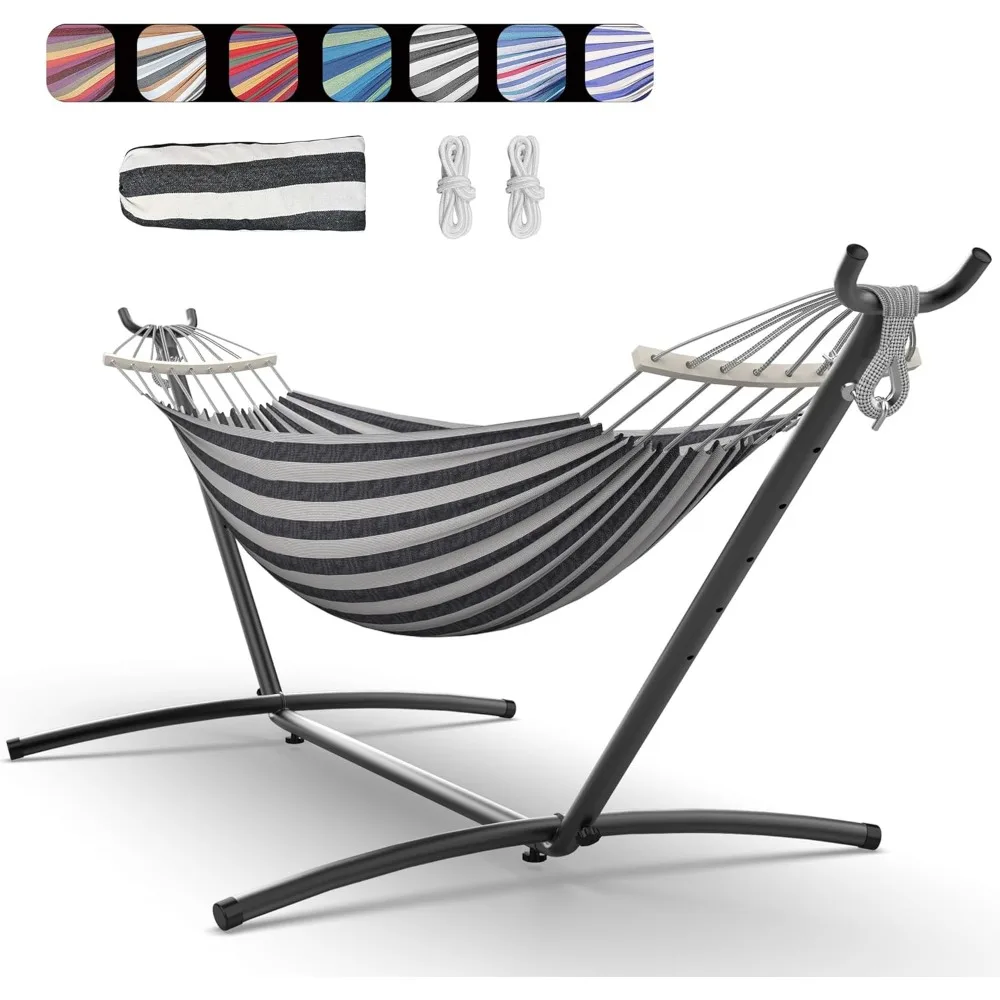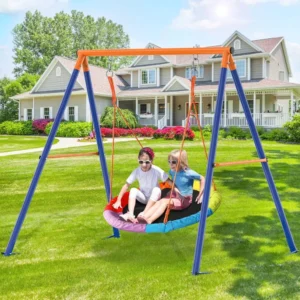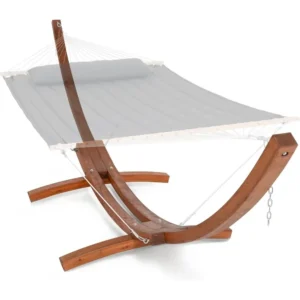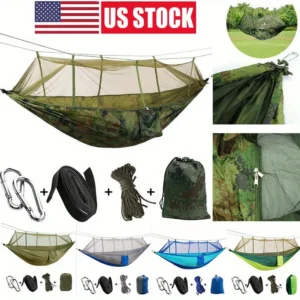The Quick Answer: Yes, But With Important Considerations
Yes, you can use a tree hammock on a stand, but it’s not always a straightforward swap. Tree hammocks and hammock stands need to be compatible in several key ways for safe and comfortable use.
Before attempting to hang your tree hammock on a stand, consider these essential factors:
- The length of your hammock must work with the dimensions of your stand
- The weight capacity of your stand must exceed your weight plus the hammock
- Your hammock’s suspension system may need adaptation to work with stand attachment points
- Safety considerations are crucial to prevent tipping or collapse
Throughout this guide, we’ll explore everything you need to know about using tree hammocks with stands, providing practical solutions for creating a safe and comfortable setup regardless of where you want to relax.
Understanding indoor and outdoor hammock placement options will give you additional flexibility when using your hammock with a stand.
Understanding Different Hammock Types and Their Design Intentions
To determine if your tree hammock will work with a stand, it’s important to understand how different hammock types are designed and what makes them unique.
Tree Hammocks vs. Stand-Designed Hammocks
Tree hammocks (often called camping or backpacking hammocks) are primarily designed for suspension between trees. They typically feature:
- Gathered ends that bunch the fabric together at suspension points
- Lightweight, packable materials
- Flexible suspension systems using straps, ropes, or whoopie slings
- Asymmetrical designs for flat diagonal laying
In contrast, stand-specific hammocks often have:
- Spreader bars that keep the fabric taut and flat
- Fixed-length designs optimized for standard stand dimensions
- Simpler suspension systems with hooks or chains
- Materials chosen for comfort rather than weight savings
Comparison of Key Features
| Feature | Tree Hammocks | Stand Hammocks |
|---|---|---|
| Typical Length | 9-11 feet | 11-15 feet |
| End Design | Gathered/bunched | Often spreader bars |
| Suspension | Adjustable (straps/ropes) | Fixed (chains/hooks) |
| Weight Capacity | 250-400 lbs | 250-500 lbs |
| Primary Use | Camping/outdoors | Home/yard relaxation |
The differences in design directly impact compatibility. Tree hammocks may require more adaptation to work with stands due to their suspension systems and length requirements.
Following proper hammock installation requirements and safety guidelines ensures your setup will be both comfortable and secure. For options specifically designed for outdoor use, browse our selection of camping hammocks with compatible stands.
Critical Compatibility Factors: Will Your Tree Hammock Work With a Stand?
Understanding these three key compatibility factors will determine whether your tree hammock can safely work with a stand.
1. Length Relationship
The most critical factor is the relationship between your hammock’s length and the stand’s dimensions:
How to measure your hammock correctly:
* Lay your hammock flat and measure from end to end (not including suspension)
* For gathered-end hammocks, measure the fabric portion only
* Add approximately 2 feet to account for each suspension end
Stand dimensions that work best:
* Most hammock stands range from 6-15 feet in length
* Your stand should be 2-4 feet shorter than your total hammock length (including suspension)
* Ideal hammock-to-stand ratio: A 10-foot hammock typically needs a 7-8 foot stand
The sag factor: Tree hammocks require proper sag (around a 30° angle from horizontal) for comfort. Your stand must accommodate this curve while maintaining proper height from the ground.
2. Weight Capacity Alignment
Your stand must safely support:
* Your body weight
* The hammock’s weight
* Dynamic forces from movement (add 10-15% buffer)
Most quality stands support 250-500 pounds, but always verify the specific rating for your model.
3. Suspension System Compatibility
Tree hammocks use various suspension systems that may need adaptation:
- Webbing straps: May need carabiners or S-hooks to connect to stand hooks
- Rope systems: Often require hardware adapters for secure connection
- Whoopie slings: May need additional hardware for fixed-point attachment
- End loops: Often the easiest to adapt to stands with minimal hardware
Finding ideal hammock locations in your home or yard will help you determine the best setup for your space.
Safety First: Ensuring Your Hammock-Stand Setup Is Secure
Safety should always be your priority when using a tree hammock on a stand. Improper setups can lead to falls, stand collapse, or equipment damage.
Warning Signs of an Unsafe Setup
Pay attention to these red flags:
* Wobbling or swaying of the stand during entry or while lying in the hammock
* Creaking or unusual sounds from the stand under tension
* Excessive bending of stand components
* Stand legs lifting from the ground when the hammock is in use
* Hammock hanging too high (more than 24 inches from the ground)
Secure Attachment Guidelines
Follow these principles for safe attachment:
* Use locking carabiners or secure knots for all connection points
* Ensure suspension components are rated for at least 2-3 times your body weight
* Distribute weight evenly across both ends of the stand
* Check that all stand bolts and components are fully tightened before use
* Position the stand on flat, level ground for maximum stability
Testing Your Setup
Before fully committing your weight:
1. Set up your hammock at a low height (12-18 inches from ground)
2. Apply gradual weight to the center of the hammock
3. Listen and look for any signs of stress or movement in the stand
4. Test gentle side-to-side movement while gradually adding more weight
5. Only when confident, slowly enter the hammock
Understanding the differences between steel vs wood hammock stands can help you choose the most stable option. For maximum security, especially for heavier individuals, consider our heavy-duty hammock sets specifically designed for stability.
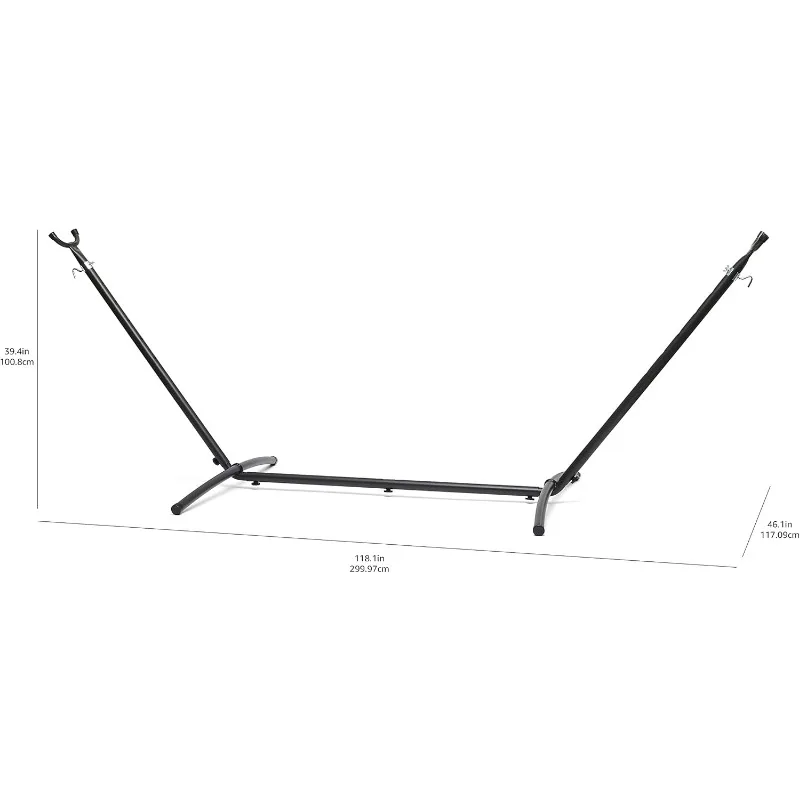
Practical Solutions: How to Successfully Adapt a Tree Hammock to a Stand
With some creativity and the right approach, most tree hammocks can be successfully adapted to work with hammock stands. Here are practical solutions for common challenges:
For Hammocks That Are Too Long
If your tree hammock exceeds your stand’s length:
1. Create shortened suspension loops using webbing or rope
2. Use chain segments to adjust the hammock’s effective length
3. Consider a “Z-configuration” where suspension doubles back on itself
4. Tie overhand knots in rope suspension to reduce length
Adapting Different Suspension Systems
For hammocks with continuous loops:
* Connect loops directly to S-hooks or carabiners attached to the stand
* Use a larks head knot to attach to a chain for adjustability
For webbing strap systems:
* Thread the webbing through the stand’s hooks and back through the buckle
* Use carabiners to connect webbing loops to the stand attachment points
For rope or cord suspension:
* Create secure loops using figure-eight knots
* Use a trucker’s hitch for adjustable tension
Achieving Proper Sag
Getting the right curve in your hammock is crucial for comfort:
1. Aim for a 30° angle from the horizontal at each end
2. Adjust suspension length to create a gentle curve, not a tight line
3. Position attachment points at approximately 2/3 the height of the stand
4. Use adjustable hardware like chain segments to fine-tune the hang angle
Hardware Solutions
These common hardware items solve many adaptation challenges:
* Climbing-rated carabiners (recommended minimum 12kN strength)
* S-hooks with safety closures
* Quick links or delta links for secure connections
* Adjustable chain segments
* Replacement tree straps with multiple attachment loops
Learning techniques for stabilizing a hammock stand will further improve your experience, especially if you notice any movement during use.
Best Hammock Stands for Tree Hammocks: Features to Look For
Not all hammock stands work equally well with tree hammocks. Here are the key features that make a stand more compatible:
Adjustable Attachment Points
Look for stands with:
* Multiple hook positions for length adjustment
* Height-adjustable suspension points
* Extendable or modular frames
* Chain or rope adjustment systems
Compatible Design Elements
The most versatile stands include:
* Wide, stable bases that prevent tipping
* Curved or angled ends that accommodate hammock sag
* Raised attachment points (at least 4-5 feet high)
* Universal hooks or connection points compatible with various suspension types
Material and Weight Considerations
Different stand materials offer various benefits:
* Steel: Maximum stability and weight capacity (typically 450-500 lbs)
* Wood: Natural aesthetic, good stability, medium capacity (typically 350-450 lbs)
* Aluminum: Lightweight for portability, lower capacity (typically 250-350 lbs)
Space Requirements
Consider the stand’s footprint:
* Length: Typically 7-15 feet
* Width: Usually 3-5 feet
* Height: Most stands are 3.5-5 feet tall
* Clearance needed: Allow at least 2 feet around all sides
Understanding the strongest materials for hammock stands will help you select a durable option that meets your needs. For those who value flexibility, our portable hammocks and stands offer excellent compatibility with many tree hammock styles.
When Adaptation Isn’t Advisable: Knowing the Limitations
While many tree hammocks can work with stands, some combinations simply aren’t safe or practical. Recognize these situations where adaptation should be avoided:
Extreme Size Mismatches
Adaptation is particularly risky when:
* Your hammock is more than 2 feet longer than your stand’s capacity
* The stand is designed exclusively for shorter spreader bar hammocks
* The stand’s height is significantly lower than needed for proper hammock sag
* Weight capacity of the stand is within 50 pounds of your body weight
Incompatible Design Elements
Some design features create insurmountable compatibility issues:
* Stands with fixed-position, narrow hooks that can’t accommodate webbing or straps
* Hammocks with specialized suspension systems that require anchor points far apart
* Ultralight hammocks not designed for the rigid attachment points of most stands
* Stands with low crossbars that interfere with proper hammock hanging
Safety Warnings
Never attempt adaptation when:
* You notice bending or deformation of the stand components under tension
* The stand becomes unstable or lifts from the ground when weight is applied
* Connection points show signs of wear, fraying, or metal fatigue
* The stand wobbles excessively even after proper setup
For comprehensive safety information across different hammock setups, refer to our indoor and outdoor hammock safety guide.

Alternative Options: When to Consider Purpose-Made Equipment
When adaptation proves challenging or unsafe, purpose-made equipment offers reliable alternatives.
Specialized Hammock Stands
Several manufacturers now produce stands specifically designed for camping and tree hammocks:
* Portable frames with adjustable width
* Tensioning systems that accommodate gathered-end hammocks
* Collapsible designs for easy transport and storage
* Higher attachment points that allow proper hammock sag
Universal Hammock Stands
These versatile options work with nearly any hammock:
* Adjustable length frames that expand or contract
* Multiple attachment points at various heights
* Convertible designs that adapt to different hammock styles
* Heavy-duty construction with higher weight capacities
Space-Saving Alternatives
When space is limited:
* Wall-mounted anchor points can replace one end of a stand
* Single-post stands can work with existing anchor points
* Doorway tension systems offer indoor options
* Freestanding tripod stands require less floor space
For the perfect combination of hammock and support, browse our complete camping hammock systems designed to work together seamlessly.
Supplemental Content: Making Your Hammock-Stand Setup More Comfortable
Once you’ve successfully adapted your tree hammock to a stand, these comfort enhancements will maximize your relaxation experience.
Finding the Ideal Lying Position
Q: How should I position myself in a tree hammock on a stand?
A: Lie diagonally across the hammock at approximately a 30-45° angle from the centerline. This creates a flatter, more ergonomic position for your back and prevents the sides from wrapping too tightly around you.
Adding Comfort Accessories
Q: What accessories improve comfort when using a tree hammock on a stand?
A: Consider adding:
* Underquilts that hang beneath the hammock for insulation
* Thin sleeping pads for back support
* Small pillows specifically designed for hammocks
* Ridgelines for attaching accessories or hanging items
Addressing Common Discomforts
Q: How can I prevent shoulder squeeze in my hammock?
A: Ensure proper sag in your hammock and lie diagonally. You can also add a structural ridgeline to maintain consistent sag regardless of weight.
Q: How do I stop my legs from hyperextending in a hammock?
A: Place a small pillow or rolled towel under your knees, or adjust your diagonal position to create a flatter lay.
Weather Protection Options
Q: Can I add rain protection to my hammock-stand setup?
A: Yes! Many hammock sets with canopies provide integrated weather protection, or you can add a separate tarp suspended above your hammock for rain and sun protection.

Frequently Asked Questions About Tree Hammocks and Stands
Q: Can camping hammocks work with indoor stands?
A: Yes, most camping hammocks can be adapted to indoor stands with proper hardware. Ensure the stand is rated for your weight and has adequate length to accommodate the hammock’s natural curve.
Q: Do Brazilian hammocks work with standard hammock stands?
A: Brazilian hammocks typically work well with stands because their traditional design includes end loops that adapt easily to stand hooks. You may need to adjust the hanging height for proper sag.
Q: How portable are hammock stands for camping?
A: Purpose-made portable stands weigh 15-30 pounds and typically break down into pieces 2-4 feet long. While not suitable for backpacking, they work well for car camping or yard use.
Q: Will using a tree hammock on a stand wear it out faster?
A: Not necessarily, but the fixed attachment points may cause more concentrated wear than tree straps. Inspect suspension points regularly and consider reinforcing high-stress areas.
Q: Can I leave my hammock on the stand outdoors?
A: Most tree hammocks aren’t designed for continuous outdoor exposure. If you plan to leave your setup outdoors, choose weather-resistant materials and consider a protective cover or storage bag when not in use.
For additional guidance on setting up your hammock in various environments, our guide to perfect hammock placement for home and garden provides helpful tips.
Camping Hammock Sets with Bug Net, Ultralight Camping Hammock Sets
$139.72 Select options This product has multiple variants. The options may be chosen on the product pageClassic Wooden Stand Hammock Sets, Heavy Duty Hammock Sets
$1,061.68 Select options This product has multiple variants. The options may be chosen on the product pageHammock Sets with Canopy, Heavy Duty Hammock Sets
$286.31 Select options This product has multiple variants. The options may be chosen on the product pageFolding Hammock Sets, Quick Setup Hammock Sets
Price range: $305.52 through $583.27 Select options This product has multiple variants. The options may be chosen on the product pageHeavy Duty Hammock Sets, Wooden Arc Stand Hammock Sets
$878.66 Select options This product has multiple variants. The options may be chosen on the product pageCamping Hammock Sets with Bug Net, Complete Camping Hammock Systems
Price range: $82.73 through $97.96 Select options This product has multiple variants. The options may be chosen on the product page
Conclusion: Creating Your Ideal Hammock Experience
With the right approach, many tree hammocks can indeed be successfully used with hammock stands. The key is understanding the compatibility factors—length, weight capacity, and suspension system—and making appropriate adaptations when necessary.
Remember that safety should always be your priority. Take time to test your setup carefully, ensure all connection points are secure, and verify that the stand remains stable under your weight.
Whether you’re bringing your camping hammock indoors for the winter or seeking more flexibility in where you hang your hammock, a proper stand setup can provide the relaxation you’re seeking without requiring perfectly spaced trees.
For the easiest experience, consider our quick-setup hammock sets that take the guesswork out of compatibility and provide everything you need for immediate relaxation.

